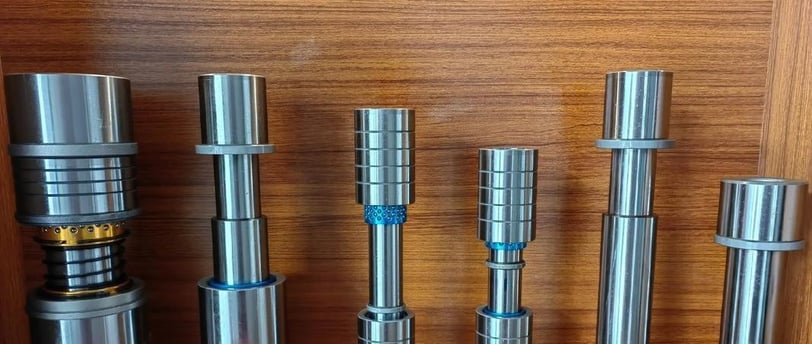High-Precision Stamping Mold Design Points
1/26/2025


Understanding High-Precision Stamping
High-precision stamping is a sophisticated manufacturing process which involves the shaping and cutting of materials, typically metal sheets, to produce intricate parts with exceptional accuracy. This technique has gained significant traction in the manufacturing industry, particularly due to its ability to produce high-volume components while maintaining tight tolerances. Compared to traditional stamping methods, high-precision stamping offers several advantages, notably enhanced accuracy, cost-effectiveness, and improved efficiency. These factors are instrumental for manufacturers aiming to meet stringent quality standards and maintain competitive edge.
The advantages of high-precision stamping are multifaceted. Firstly, the precision of this method allows for complex geometries and detailed designs that traditional stamping processes may struggle to achieve. This level of accuracy reduces the need for secondary operations, significantly streamlining the production process and lowering overall manufacturing costs. Additionally, the efficiency of high-precision stamping translates into faster production rates, making it an attractive option for high-demand industries.
Key applications of high-precision stamping span several sectors including automotive, electronics, and medical devices. In the automotive sector, high-precision stamped components are essential for ensuring safety and performance in vehicle manufacturing. The electronics industry benefits from precision stamped parts, which are used in circuit boards and connectors, helping to minimize space and optimize functionality. Similarly, in the medical device sector, high-precision stamping ensures the reliable production of intricate components that must adhere to strict regulatory standards.
Understanding the fundamental concepts of high-precision stamping is crucial for grasping the intricacies of stamping mold design. Various factors, such as material selection, die design, and machining processes, play pivotal roles in ensuring successful outcomes. As such, an in-depth comprehension of these elements is necessary for anyone looking to delve into the realm of high-precision stamping.
Key Design Considerations for Stamping Molds
When designing stamping molds for high-precision applications, several key factors must be taken into account to ensure optimal performance, reliability, and longevity. One of the foremost considerations is material selection. The choice of material directly impacts the mold’s durability, wear resistance, and overall performance during the stamping process. Commonly utilized materials include tool steels, which offer excellent hardness and wear characteristics, along with alloys that enhance specific properties like corrosion resistance. It is imperative to evaluate the material not only for its mechanical properties but also for its compatibility with the intended stamping processes and materials.
The geometry of the mold plays a critical role in the effectiveness of operations. A well-designed mold must embody precise features that accommodate the contours and specifications of the component being produced. This includes aspects like draft angles, radii, and vents, which are essential in facilitating the ejection process and reducing wear during operation. Careful consideration of mold geometry can lead to improved efficiency, minimizing the risk of defects and enhancing the production quality.
Tolerance levels are another vital element in the design of high-precision stamping molds. High-precision production often demands tight tolerances that can significantly impact the functional and aesthetic quality of the finished product. Accurate tolerancing not only dictates the fit and performance of individual parts but also defines the assembly processes applicable in post-stamping operations. Furthermore, balancing complexity with manufacturability is crucial; while innovative designs may enhance performance, overly complex molds can lead to increased costs and production times. Thus, achieving an optimal balance is essential for efficient and effective mold design.
Technology and Tools in Mold Design
The process of high-precision stamping mold design is highly dependent on modern technologies and specialized tools that enhance productivity and accuracy. Advanced software solutions play a pivotal role in this landscape, particularly through the implementation of Computer-Aided Design (CAD) tools. CAD systems empower designers to create detailed three-dimensional models of molds, allowing for a higher level of precision and better visualization of the design before the actual production begins. The capabilities of CAD facilitate efficient modifications, ensuring designs meet stringent specifications required in high-precision applications.
In tandem with CAD, Finite Element Analysis (FEA) tools are indispensable in the mold design process. FEA allows designers to simulate how parts will behave under certain conditions, including stress, heat, and deformation. By predicting potential issues and performance metrics, FEA plays a critical role in optimizing mold integrity and functionality, thus reducing costly prototyping cycles and enhancing overall productivity.
Simulation tools further add value by enabling designers to evaluate the entire stamping process digitally. These tools can recreate real-world conditions, allowing designers to identify potential problems and implement solutions prior to actual manufacturing. Such foresight is instrumental in streamlining workflows and mitigating risks associated with mold production.
The impact of automation in mold design cannot be overstated. Employing automated tools assists in streamlining repetitive tasks, reducing manual errors, and increasing efficiency. Additionally, the integration of additive manufacturing techniques, such as 3D printing, has significantly transformed the prototyping phase. This technology allows for rapid prototyping, enabling designers to quickly produce and test mold components, thus accelerating the development cycle. Coupled with innovative tooling technologies, these advancements create a more agile design environment, yielding high-precision stamping molds that meet the evolving demands of various industries.
Best Practices and Future Trends in Stamping Mold Design
High-precision stamping mold design is a critical aspect of manufacturing that demands careful consideration to enhance efficiency and effectiveness. Implementing best practices in this area can significantly improve mold accuracy and extend the lifespan of the tool. One essential practice is to choose the right materials for the specific application, as each material offers different benefits in terms of wear resistance and thermal stability. Regularly calibrating molds and utilizing advanced design software can also contribute to maintaining mold precision and minimizing the likelihood of defects during production.
In addition to material selection and precision calibration, establishing a rigorous maintenance protocol is vital. This includes regular inspections to identify wear and tear, ensuring that components are replaced before potential malfunction. Implementing a documentation system for maintenance records allows manufacturers to track mold performance and establish preventive measures. It is crucial to foster a culture of continuous improvement, encouraging feedback from operators, which can lead to refinements in the mold design and operation. Such proactive strategies can significantly mitigate downtime and optimize productivity.
Looking ahead, the stamping mold design landscape is poised for significant transformation driven by emerging technologies. Innovations such as smart sensors integrated into molds will facilitate real-time monitoring of performance metrics, providing valuable data for adjustments during production. The influence of Industry 4.0, characterized by automation and data exchange in manufacturing technologies, will lead to enhanced customization and flexibility in mold design, enabling manufacturers to respond swiftly to market needs. As these trends continue to evolve, it is crucial for professionals in the stamping industry to stay informed and adapt their practices to leverage these advancements effectively. This approach will ensure high-precision stamping mold design remains an integral aspect of modern manufacturing processes.
